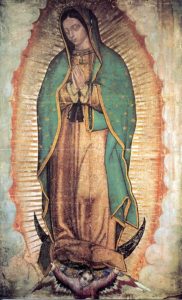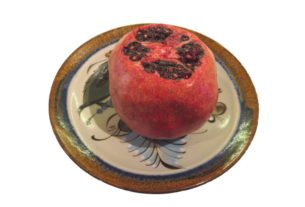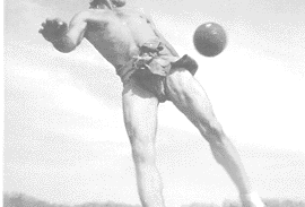Felipe Avila handed me his burning candle, converting me from spectator to pilgrim in the Fiesta de Guadalupe!
My arrival in Puerto Vallarta coincided with the beginning of the weeklong Fiesta de Guadalupe, Reina (queen) de México. From December 6 until December 12th, Mexicans celebrate the miracle of her appearance in 1531. On a barren hill, a beautiful dark-skinned woman spoke to a young indígeno (native) declaring herself to be the Virgin Mary, Mother of Jesus Christ. She told Juan Diego, the young peasant, that it was her desire to have a church built on that hill formerly sacred to the Aztec’s mother of all gods, Tonantzin. As a sign to the Bishop of her identity, she instructed Juan Diego to pick roses from the desolate hill. When he delivered the roses to the Bishop, a perfect image of La Virgen Morena (the Dark Virgin) appeared emblazoned on his cloak. Today the miraculous image, that experts are at a loss to explain, is viewed annually by millions of the devout and the curious in the Basílica de Guadalupe in Mexico City. On a wall written in large characters are the same words La Virgen spoke to Juan Diego, so long ago:
“Don’t be afraid. Am I not here, Me, your mother? Do you need anything else?”

Her image is everywhere – in the buses and taxis, in stores, on postcards, tattooed on arms, woven on matador’s hats, chalked on mountainsides, flowered in public parks, outlined in neon…
There’s a popular saying in Mexico:
“There’re really two jefes (bosses) of Mexico – the President of the Republic and La Virgen of Guadalupe.”
I’m always interested in knowing ‘who’s who’. So if La Virgen is the first lady of Mexico, it was time to get to know her.
For this visit to Puerto Vallarta, my two teens, Josh and Rose, and myself flew from Vancouver, Canada. I chose to stay in an older hotel south of the Rio Cuale. Local buses run frequently by P.V.’s modern airport and arrive twenty minutes later in the south end of the city. Lurching along in the heart of old Vallarta, our bus ground to a corner and the driver commanded the puzzled passengers to get off. Nearby, a policeman, in gleaming pith helmet and khaki shorts, waved his gloved hands urgently while blowing his whistle, directing all traffic away from the bridge.
The main streets seem closed to traffic. Today is December 6th. Could this be the beginning of the fiesta?
Fortunately taxis still scuttled over both downtown bridges and one sped us quickly to our hotel. I’d planned our month’s stay in Mexico to coincide with La Fiesta de Guadalupe but had no schedule of events. Was it serendipity that placed our hotel near the street corner where began each procession to the La Parroquia de Nuestra Señora de Guadalupe, the city’s patron saint?
On the second night of our stay, I watched with interest as the entire staff from our hotel and the café next door busily prepared for their walk to the catedral.
Many of the hotels in colorful old Puerto Vallarta traditionally celebrate this annual homage to La Virgen de Guadalupe. Each evening of the fiesta, a different hotel, its owners, their extended families, and staff with family, form a procession to the catedral. Tonight’s large flatbed truck transformed into a fabric-draped float for a scene depicting el milagro (miracle). A large circle of plastic pressed up against the cab of the truck. In front of this translucent plastic halo, a beautiful young señorita draped in a turquoise shawl serenely clasped her hands in prayer. At her feet, knelt a boy dressed in homespun cotton fringed with red indígena motifs. Surrounded by homemade flowers, he played the penitent young Juan Diego to whom the miracle first appeared. The two young people froze like statues on the float until the catedral was reached. Descending the wrought iron spiral staircase from our balcony I joined the front desk clerk. Wide-apart hazel eyes glanced over a broad smile as Felipe Avila carefully passed his dripping candle. He shared his song sheet so we could sing together in Spanish. Rose, thirteen and her older brother Josh, fifteen, peered over the balcony.
“Mom! You’re not going in that parade! Are you?”
“Sure! See you guys. In a couple of hours.”
Long straight hair shook over two sets of brown eyes.
Generation gap translation: ‘That’s our mom for ya! What are we going to do with her?’
With cherry light flashing, the policeman started his car’s engine, slowly spear-heading our procession through the streets. Tucked tightly behind the float, three singing guitarists, two trumpeters and one bass drummer strummed, blew and pounded the unforgettable rhythm of their piece. Excruciating from a gringa’s standard but performed with an exhilarating zest. And we sang:
Buenos dias, paloma blanca
hoy te vengo a saludar
saludando a tu belleza
en tu reino celestial
en tu reino celestial
Buenos dias………….
Good morning, white dove,
Today I come to greet thee,
Greeting thy beauty
In your celestial rein.
In your celestial rein.
Drawn by the music and the singing, bystanders clustered on crowded sidewalks. Mexican men, women and children paused, respectfully, to witness the pilgrimage. Emerging from a fragrant panadería, a graying señora dropped tissue wrapping paper, wiped her hands clean upon her apron and stepped to the sidewalk. Children dismounted battered bicycles and staggered them against graffiti-splashed concrete walls. Earnest businessmen broke step and gazed thoughtfully towards the serpentine procession. Young lovers unclasped embraces and turned flushed faces to the street. Winding slowly over the upper bridge crossing the Rio Cuale, the procession drew towards the catedral.
The church wears a very unusual large crown, modeled after the crown of the tragic 19th-century Empress Carlota. It tops the tower of the new church, built in 1951. Passing by La Plaza de Armas with its ornate bandstand, our procession further flooded the narrow street already pulsating with people. Out of small carts drifted the heady aroma of tacos and steaming pork tamales. The frying of enchiladas crackled above the hubbub. Hawkers of ballpark-caliber souvenirs squawked the virtues of their wares alongside solemn purveyors of holy trinkets. Whole families perched on tiny stools, tasting the wealth of Mexican specialties. From little canvas-topped puestos (booths) vendors offered drinks, ice cream, sweets, balloons and toys for children. Mariachi music blared from loudspeakers at Los Arcos, an open-air stage on the malecón. (Seawall-walkway) A deep, heaving sound, a blessing spoken in a throat of bronze tolls for the ‘Alma’ or soul of the people. It summons them to the catedral for spiritual renewal amidst the glitter, glamour and perhaps even decadence of a huge world-class resort.
Look at the color! Look at this riotous crowd and hear its laughter!
I climbed with dripping candle up the wide stone staircase. While entering the great wooden doors of the catedral, I glanced around its cavernous interior. Felipe touched my shoulder lightly, guiding me to the side of the church to stand with the people from my hotel. Over the crackling loudspeaker the priest chanted greetings to hundreds of penitents’ pouring into the catedral. Suddenly the crowd split apart as secondary school students strode briskly up the center aisle towards the altar. Marching smartly with the precision of a military tattoo, the troupe flailed the sides of their snare drums.
Ay! The enthusiasm of youth!
The high vaulted ceiling echoed a deafening eardrum assault. Ecstatic drumming made for fine fiesta frenzy.
Sending the sound to the heavens for La Virgen?
La Virgen de Guadalupe is the symbolic mother of the Mexicans. In their faith, she represents the ideal of purity in woman and the enduring nature of a mother’s love. She symbolizes a cross between a saint and the mother of Jesus, always kind, tender, loving, loyal, and self-sacrificing.
Contemporary Mexico is generally ‘a society of mothers’ who dedicate themselves to their families. Life within the family’s household revolves around them. Thus La Virgen de Guadalupe retains her enduring presence into the twenty-first century.
These days our society encourages the blame of others, fate, global economics and other factors over which we feel little control. Often rewards are given for succumbing to self-pity, despair or materialistic hedonism. For me, La Virgen de Guadalupe provides an alternate image of support. As I face the daily grind, the inequalities and challenges of life, she offers unconditional love, giving a big hug and firm push—–you go, girl! Symbolic of a mother’s idealized love, the image powerfully nurtures my psyche.
Some may criticize this faith and claim that it holds a woman in bondage to a patriarchal society. Perhaps. Much of my attraction to Mexican people revolves around their profound appreciation of women and motherhood. But if I lived in this country would I lose my own society’s social independence for women, hard-won after generations of struggle? Turn back the clock?
What about——full partnership in relationship and economics, independence of thought combined with the traditional Mexican appreciation of motherhood? Wouldn’t that be something!
As my teen Rose might ask, “What’s the color of the sky in your world, Mom?”
La Virgen de Guadalupe also bonds to the very fabric of national identity. In the words of my estimado amigo Frederico de Robles, in Guadalajara:
“Our Lady of Guadalupe has accompanied us in war and peace, in joy and grief, in life and death. She was the standard for Hidalgo y Morelos armies. She has been invoked and sought by us in times of despair and destruction, in times of serenity and reconstruction, then and now, as She will be tomorrow. I know that I can be a perfect Catholic and still not believe in Her. But I don’t see how can anyone consider herself or himself truly a Mexican without trusting in the Lady from Heaven, Nuestra Señora de Guadalupe.”
Over the week I watched or walked in more processions to the catedral. Each time, although the appearance and materials differed, La Virgen de Guadalupe and Juan Diego commanded the float. The bands changed numbers of players, costumes and instruments but always played that same tune! Sometimes pilgrims wore different matching clothing and carried various styles of flares or candles. Often school-age children dressed in colorful homemade costumes, simulating traditional indígena dancers. Rhythmically shaking their instruments with gusto and joy, they danced towards the catedral. Those evenings, pleasant petals of sound carpeted the street.
The processions continue nightly in Puerto Vallarta until La Fiesta de Guadalupe’s climax on December 12. By that date my teens and I had traveled south to our next destination. Fiestas de Guadalupe occur all over Mexico. I’d like to return on this date again. Light candles, walk in the procession and sing that old song again!
“From the sky she came triumphant, she came to give us peace, from the sleep she woke me up…” Indigenous hymn


